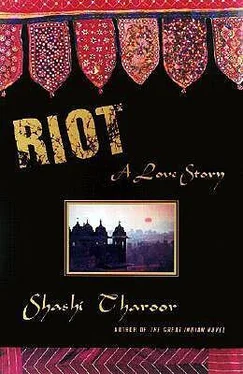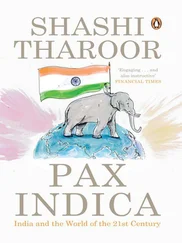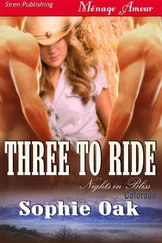I told you that earlier that morning I’d never seen the DM so furious. This time he exceeded himself. You’ve seen Lucky; he’s a soft-spoken, thoughtful, calm, and restrained individual. Now everyone was stunned to see him explode with all the unpredictable velocity of a soothli bomb. He shouted at the men in the station house. “You’re crooks, not police!” he ranted. “You’re deceitful, communal-minded bigots, not fit to wear your uniforms!” He was working himself into quite a state. “Go and find the murderers you’ve released. Go now! I’ll personally chase you right up to the gates of hell if the ten released men are not rounded up again within the hour.”
“Lucky,” I murmured, “I couldn’t have done better myself.” I took the best of my police officers and rushed back into town. You should have seen the expressions on the faces of some of the ten accused men when they were rearrested. Like society matrons finding a horny hand up their saris. This time Lucky and I personally supervised the filing of the charges — the preparation of documents for the courts.
The charges may or may not stick when they come to trial. But you should know that the Sessions Court released the accused Hindus on bail within a frigging week. The Muslims who had been rounded up in the bomb case are still being refused bail. The DM went to see the fucking district judge and said, “I have never tried to interfere with the judicial process. But here — the same riot, the same offenses, the same sections of the Penal Code — how can there be two such openly different standards for people of two communities? It is not an ordinary case,” he added. “It is a question of the faith of a whole community in the system of justice in our country.”
But the motherloving district judge refused to even discuss the issue with the DM. We do our job, Randy. I just wish everyone would do theirs as well.
Let me tell you something about these bloody riots — ours, and the others across northern India. They’re like a raging flood. When the stormy waters recede, all you will see left behind are corpses and ruins. Corpses, Randy, and fucking ruins.
Priscilla Hart. I knew you wanted to talk about Priscilla. I’m just trying to get you to understand why we don’t know much about what happened to her. We had enough on our minds at the time. But I’ll tell you what I know, Randy. Let’s have another drink first.
from transcript of Randy Diggs interview
with Professor Mohammed Sarwar
October 12, 1989
Look, I’m a historian, not a political activist. Though if you asked me, as a Muslim historian, whether I was a Muslim first or a historian first, I would have to tell you that depended on the context. But your question deserves a reply.
Isn’t it amazing how these Hindu chauvinist types claim history on their side? The precision, the exactness, of their dating techniques are enough to drive a mere professor like me to distraction. People like me spend years trying to establish the veracity of an event, a date, an inscription, but the likes of Ram Charan Gupta have not the slightest doubt that their Lord Rama was born at the Ram Janmabhoomi, and what’s more, at the precise spot they call the Ram Janmasthan — not ten yards away, not ten feet away, but right there. Their own beliefs are that Rama flourished in the treta-yuga of Hindu tradition, which means that their historical exactitude goes back, oh, about a million years. What is a mere historian like me to do in the face of such breathtaking knowledge?
The poor professors, alas, have not been able to establish with any certitude whether Lord Rama was born at all or simply emerged, wholly formed, from the creative and devout mind of the sage Valmiki, the putative author of the great religious epic the Ramayana. But if he was born, as the epic claims, in Ayodhya, there is no certainty that it was the place we today know as Ayodhya, in Uttar Pradesh — just as we can’t be sure if the Lanka he conquered to retrieve his kidnapped wife Sita is the Sri Lanka of today, rather than somewhere in Central India. The Vedas, the old Hindu scriptures, mention Rama as a king of Varanasi, or Benares, not of Ayodhya. One of the Jatakas, the Dasaratha Jataka, also says that Dasaratha and Rama were kings of Varanasi. There’s more. The Ramayana actually mentions the Buddha, who lived around 500 B.C., but at that time the capital of the kingdom of Kosala, Rama’s kingdom, was Sravasti, not Ayodhya, and the Ayodhya described in the Ramayana could not possibly have existed before the fourth century B.C. There are other inconsistencies, but you get the picture.
Now to the date of his birth. Simple fact: neither the seven-day week nor the division of the months into thirty days was included in the Hindu calendar, the Panchang, until the fourth century A.D. So even if Rama was a historical rather than a mythological figure, you have to get into a lot of guesswork before you date him. The Ramayana has suggestions that Rama lived in the dwapara-yuga, about five thousand years ago, rather than the treta-yuga of traditional belief. There is a Hindu pundit, a learned man, though without a degree in history as far as I know, a man called Sitanath Pradhan, who goes so far as to declare that the great climactic battle for Lanka was fought in 1450 B.C. and that Rama was exactly forty-two years old at the time. On the other hand, historians dating the existing texts of the Ramayana pretty much agree that it was composed sometime between 400 B.C. and A.D. 200, which is also the period in which that other great epic the Mahabharata was written, give or take a couple of hundred years. Confused enough? Your Hindutva types are presuming to know the exact place of birth of a man whose birthdate is historically unverifiable.
I know there are people who’ll say, Ignore these pettifogging historians, how does it matter? All that matters is what people believe. But there too, my historian’s inconvenient mind asks, when did they start believing it? The Ramayana existed as a text, as an epic, for about a thousand years before anyone began treating it as sacred. There is no evidence of any temple being built to worship Rama anywhere in India before the tenth century A.D. It’s ironic, when you see the passions stirred around Rama’s name in northern India today, that it was first in the South that Rama became deified. The Tamil Alvars, who were poets and mystics, started idealizing the god-king from around A.D. 900; it was a Tamil poet, Kamban, who started the cult of Ramabhakti, the divinity of Rama. The first community of Rama worshippers, the Ramanandins, came into existence in Kashmir between the fourteenth and the sixteenth centuries. And then the great poet of these parts, Tulsidas, wrote his brilliant, moving Ramcharitmanas in the sixteenth century, sanitizing the deeds of Rama, removing all those aspects of his conduct that had been questioned as less than godlike in the earlier Puranas, and elevating Rama to his present unchallenged supremacy in the Hindu pantheon. Actually Tulsidas’s Ramayana, with all its idealizing of Rama as the ideal man and its barely veiled anxieties about women as the objects of lust in need of protection, owes more than a little to the Muslim invasions of India at the time. The Rama cult, and its offshoot the Bhakti movement, rose during the period of the Muslim conquest of North India and the establishment of the Delhi Sultanate, when Hinduism was on the defensive and where the position of women, who had traditionally been quite free, changed for the worse. Women were put into purdah, away from the prying eyes of the Muslim conquerors; Islamic attitudes towards sexuality and male dominance, emerging from a nomadic warrior society, directly influenced the softer, more liberal and tolerant but now effete Hindu society. Someone ought to do a Ph.D. on the role of Islam in the sanctification of Rama, but I wouldn’t take a life insurance policy out on him these days.
Читать дальше












